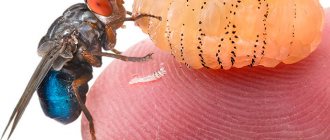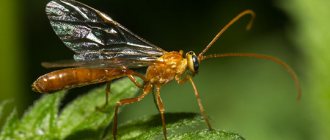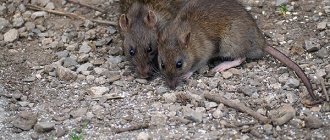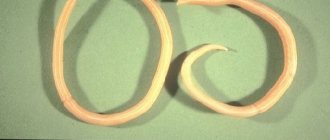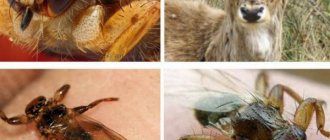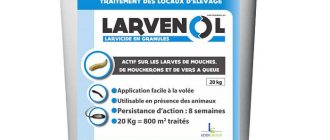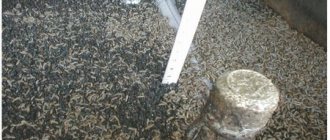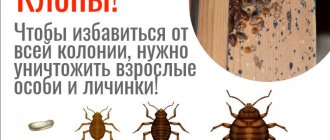Flies constantly annoy humans during the warm season. And all measures to combat them generally give a short-term effect, since these insects are able to penetrate into an apartment or house without much difficulty.
The main function of flies is reproduction. Therefore, females lay eggs in any suitable places and after some time larvae emerge from them. And since maggots feed on many foods that humans eat, the likelihood of them being swallowed is quite high. Therefore, it is worth understanding what this means for human health.
Where do flies lay their eggs?
Females initially worry about future offspring. Therefore, flies lay eggs where the larvae can fully feed and develop immediately after birth, since without food they die after 2 days.
In nature, this is usually organic waste of a liquid consistency, since the mouthparts of maggots are not designed for solid food. At home, the fly tries to lay eggs on human food.
Receptors on the legs, which act as an organ of touch, help the insect find the optimal place for its offspring. Then the fly uses its proboscis to check the consistency and taste of the product, and only after that it lays eggs.
Contaminated Meat
Suitable for this:
- meat;
- fish;
- fruits;
- vegetables;
- offal;
- cottage cheese;
- cheese.
Ready-made meals based on cereals can also serve as food for offspring. In order for an insect to lay eggs, it is quite enough to leave food on the table for a short time during the warm period of the year.
What you need to know about flies
There are more than 4 thousand species of this insect in the world. All of them, without exception, can cause discomfort and cause some harm to humans, but their role is important in the food chain of many animals and especially birds. In the territory of the former CIS, exophilic and endophilic flies are most often found. Both of them can live in a person’s home, causing considerable discomfort.
The danger may come not from the insects themselves, but from the fly larvae.
For example, in the Wohlfarth fly, which we are used to seeing near agricultural buildings, the larvae are carnivorous, and in the most advanced cases they can lead to disability. Green, shiny flies are no less dangerous; they are called meat flies.
There are many species of these insects that live near humans, which can also bring certain benefits.
Tahina is considered to be such a species - this insect destroys caterpillars in gardens and fields. But the ktyr, with its sharp sting and poison, destroys mosquitoes, midges and other blood-sucking insects. There are blood-sucking representatives of the genus Diptera, which cause certain harm to people and animals. They are called bloodsuckers of horses, dogs and deer. The bite of such individuals cannot go unnoticed - the fly digs its sharp proboscis into the body and drinks blood. Their larvae, accordingly, are carnivorous and require a living organism as a home for development.
The optimal environment for laying eggs and inhabiting flies are places favorable for the development of bacteria, infections and other negative factors - these are landfills, dung beetles, toilets and garbage cans. It is this unsanitary environment that is favorable for the reproduction of these insects.
The developmental stages of these arthropods are fleeting; in literally 15-20 days, the fly turns from an egg into an adult, capable of laying new eggs. It is worth saying that in one clutch it is capable of producing from 100 to 150 eggs.
Fly larvae appear on the fifth day from small white eggs, the size of which is no more than 1.2 mm. After a week, these white worms change their appearance and turn into a kind of pupa. Their skin takes on a dark brown color and becomes significantly rougher, which provides protection for the insect while it is inside. After 10 days, an adult emerges from the pupa, which is able to begin mating and after 2-3 days lay new eggs.
Some species can be called viviparous, since they carry eggs within themselves and insect larvae are born, which are at the stage of pupal formation.
The fly can lay larvae anywhere - it can be manure, food or lost food, garbage, or even a wound on the animal’s body. It all depends on the type of dipteran and its mode of life. The fly larvae, hoverflies, are capable of eating more than 2 thousand aphids over the entire period of their development.
Types of larvae
There are about 3.5 thousand species of flies in nature, but only a few of them penetrate into a person’s home. Finding favorable conditions here, they lay eggs, from which larvae subsequently emerge.
Maggot
In addition to the larvae of ordinary houseflies, the following species can be found in an apartment:
- Maggot . The length of the insect reaches 15 mm. This species is the offspring of the blue carrion fly. Maggots can appear in meat and fish.
- Gozzer . This is the larva of the black-headed blue fly. Characterized by rapid pupation. The size of the insect at the last stage of development reaches 20 mm.
- Gordini . The maggot of a gray blowfly, the size of which reaches 20-25 mm. The larva quickly pupates.
- Pinka . This species is the offspring of the green blowfly. The body length of the larvae does not exceed 10 mm.
- FIFA . Lucilia fly maggot. Belongs to the category of frost-resistant species. The length of the larva does not exceed 12 mm.
Appearance of larvae and what they are
Gadflies lay eggs under human skin, where the larvae develop. In appearance they resemble the shape of a pear. There are rows of spines across their body, and a sclerotic capsule is located below. The length of the larvae can reach 25 cm, in diameter - 7 mm. With the help of hangnails, the parasite attaches itself to the tissues of the body, feeding on blood, accumulating substances useful to itself. The fluid secreted by it causes severe pain, causing a disease in a person - cutaneous myiasis.
After birth, the gadfly larva is quite small. However, under the skin of a mammal it grows very quickly and after a couple of weeks can reach a length of 20 mm.
Externally, the larva looks like a maggot. Only its body is pear-shaped with several transverse rows of spikes resembling hooks. She uses them to securely attach to the skin, hair or fur. The main food is blood.
The development cycle of a gadfly larva does not exceed 5 weeks on average. But having become an adult, it continues to parasitize the host for another 2-3 months, absorbing nutrients and receiving oxygen through a fistula formed in the epidermis. After which it tries to get out from under the skin to pupate.
Life cycle
The gadfly is an insect that has a closed chain of transformations. The complete development cycle involves the path from the larva to the adult stage. The insect lives from 3 to 20 days. By the end of life, it loses approximately 1/3 of its own body weight. Under unfavorable climatic conditions, it seems to freeze, living on plants. Any life cycles within the insect's body will be slowed down.
The gadfly larva will go through 3 stages of formation inside the human body. At all stages it has a characteristic shape:
- At stage 1, it looks like a small headless and legless white worm. At the end of the body there is a thickening with 3 black stripes. This stage of formation lasts 7 days, after which it molts and moves on to the next one.
- At stage 2, the larva is large in size and bottle-shaped. After 18 days, the insect molts and moves to the next stage.
- At stage 3, the gadfly will increase in size. After about a month, it will become an adult and will continue to stay in the host’s body for up to 10 weeks, then it will crawl to the surface of the skin and leave the person, falling to the ground.
Each stage is characterized by small black dots and spikes surrounding the thorax.
What do they look like?
Regardless of the type of fly, their eggs and larvae are similar in many ways. The difference can only be in the size and shades of color of the larvae. When magnified, a fly egg resembles the color and shape of a grain of rice. Its size is about 1-1.5 mm.
The fly larva is born approximately 2 mm in size. For each molt, it doubles in size and at the pre-pupation stage elongates to its maximum size. The weight of an adult maggot is 22-27 g, depending on the species.
The larvae can be gray, beige or yellowish in color. They have a segmented elongated body. Insects move due to false legs in the form of convex growths, which are located on the sides of the body. The insect's body consists of a head capsule, thoracic and abdominal regions. In the front part there is a mouthparts with retractable hooks. The larval chest consists of 3 segments, and the remaining 10 belong to the abdominal section.
The prepupa of a fly initially has the same color as the larva. But as she gets older, her skin hardens and darkens. The insect pupa has the shape of a barrel with pronounced transverse circular notches. It is dark brown in color.
Consequences of eating flies
The cat's body can easily digest flies , since they do not contain any complex enzymes. To fill the stomach with chitin, you need to eat a fairly large number of insects, but the animal will not do this. That is why catching and eating them is considered absolutely harmless . Even drops of dirt carried on the legs of insects are safe. But this does not mean that the kitten can be left unattended. There are a number of consequences due to which he may suffer:
- Flies are insects that carry germs and worms . Once in the pet's gastrointestinal tract, they actively multiply, negatively affecting his health. Regular preventive measures to combat helminths will help protect the animal. It is necessary to treat worms even for cats who have never walked outside in their lives. Antihelmintic drugs are given to street pets once every 3 months, to domestic pets - once every 6 months.
- The most dangerous pests are stinging ones . If the body's endurance is low, an animal may foam at the mouth, vomit or have diarrhea after being bitten by a stinging insect. If a bee, horsefly or gadfly enters the oral cavity and bites a cat on the tongue, palate or larynx, swelling may occur, leading to suffocation or anaphylactic shock. In this case, the pet will not survive.
- If the stinging insect bites outside the oral cavity (near the muzzle), the area of damage will swell slightly .
- A cat carried away by the hunting process may fall out of the window if it chases after a fly flying out through an open window. For a pet, this can end tragically, especially if he lives on the upper floors of a high-rise building. Mosquito nets on the windows will not only protect your pet from falling out, but will also prevent insects from entering the room.
- Uncontrolled behavior during the hunt sometimes leads to the pet tearing curtains, scratching furniture or breaking glass vases. You can restore furniture or sew up curtains, but sharp fragments from a vase are very dangerous. The kitten can be seriously injured by them.
What happens if you eat a fly larva?
In most cases, if you eat a fly larva, nothing bad happens. However, another development of events is also possible, which will cause serious health problems.
Myases
This parasitic disease can be caused by the larvae of the gray blowfly and wohlfarth fly. This occurs against the background of a weakened immune system and disruption of the digestive system. In this case, if a person eats a larva, it is not processed in the stomach, but enters the systemic bloodstream and any internal organ. As a result, this leads to the development of an inflammatory process and can cause weakness, fever and other health complications.
Miaz
Intestinal myiases
This type of disease develops when larvae deposited by a fly enter the human intestine. This causes inflammation of the organ mucosa, accompanied by pain in the abdomen, diarrhea, and vomiting.
The disease can develop if you swallow the larva of a housefly, housefly, blue blowfly, or cheese fly. This occurs with reduced acidity of gastric juice and aerophagia.
In most cases, the larvae die in the human body and come out with vomiting and excrement; in rare cases, surgical intervention is required.
Intestinal myiasis
Salmonella
Swallowed fly larvae can be carriers of salmonellosis. This infectious disease is accompanied by a sharp increase in body temperature, diarrhea, fever, and loose stools.
In most cases, the disease does not require special treatment and goes away on its own with diet and drinking plenty of fluids.
Salmonella
Bacterial poisoning
Flies may visit multiple food sources throughout the day, and they may carry harmful bacteria that they have collected from human or animal waste.
They can transfer these bacteria to the food people eat. Larvae that develop in contaminated food can ingest these bacteria. People who eat this contaminated food or maggots are also exposed to the bacteria and may feel unwell.
Salmonella and E. coli are examples of bacteria that flies and maggots can transmit to humans.
Salmonella
Salmonella is one of the most common causes of foodborne illness. Symptoms of salmonella infection include:
- abdominal cramps
- nausea and vomiting
- diarrhea
- fever
Symptoms usually begin 12 to 72 hours after a person ingests the bacteria, and the illness usually lasts 4 to 7 days.
People with salmonella poisoning often get better without treatment. However, frequent vomiting and diarrhea can lead to severe dehydration and sometimes hospitalization. Therefore, it is important for people with salmonella poisoning to drink plenty of fluids, including clear broths and fruit juices, to replace lost fluids and electrolytes.
E. coli poisoning
There are many different strains of E. coli. While most strains are harmless, some can cause food poisoning.
Here are the symptoms of E. coli poisoning:
- stomach cramps
- diarrhea that may contain blood
- vomit
- slight increase in body temperature, usually below 38.3°C
These symptoms usually develop 1–10 days after bacteria enter the digestive tract and may last 5–7 days.
E. coli infections can vary in severity from very mild to severe, and can sometimes even be life-threatening. As with salmonella poisoning, people need to drink plenty of fluids to prevent dehydration.
Fighting fly larvae
To prevent the appearance of larvae in the house, you need to keep it clean so that flies cannot lay eggs. It is necessary to take out the trash in a timely manner, hide food in the refrigerator, put away pet food and equip windows with protective nets.
Maintain cleanliness
It is also necessary to take into account that for the development of maggots, a temperature within +12...300C is required. If you are not sure of the quality of the products, you need to heat treat them. The larvae die at temperatures above +500C.
Gray blowfly
This fly is also called a sarcophagus. She is carrion. This is a large fly, its length reaches 25 millimeters. Gray blowflies are, as the name implies, gray in color with a darker checkered or line pattern, with a yellowish-white head “divided” by a black stripe. The eyes are red, and there are white longitudinal lines on the belly. The body shape is oblong, the abdomen is covered with large setae,
Gray blowflies are rare guests in a human home and appear there only if they have something to profit from there. The sense of smell of these flies is very developed, and they are able to smell the smell of rotting meat at a very long distance. Moreover, they only need to touch the surface of the meat for many small worms to immediately begin to move on it.
The larva of this fly is characterized by extraintestinal digestion. Sometimes she is able to feed on the larvae of other insects or practice cannibalism. The blowfly larva lives on carrion for up to 10 days, after which it moves into the soil, where it turns into a pupa, and then into an adult fly.
The pupa of a blowfly can hibernate; for example, the pupae of some species of sarcophagus are able to “sleep” through the entire winter and turn into an adult only in late spring.
The blowfly feeds on the nectar of flowers, and at the same time pollinates them, carrying pollen on its shaggy legs.
The attitude towards gray blowflies, as well as other carrion species, cannot be unambiguous. Being carriers of infectious diseases, they also serve as a kind of orderlies in nature. And forensic criminologists are able to determine the time of death by the age of the larvae in a decomposing corpse.
This is a beautiful fly of a glossy emerald color with smoky wings that have a faint openwork pattern. The length usually does not exceed 8 mm. It has large reddish eyes, a rounded belly and white cheeks.
The habitat of the green blowfly is places of all kinds of sewage, decomposing animal corpses, manure, waste, but sometimes they are also found in flowering plants that have a strong aroma. The food consists of rotting organic matter, where it lays its eggs.
One female is capable of laying approximately 180 grayish or light yellow eggs, which she tries to hide in carrion as deep as possible. The larvae are born after 6-48 hours and continue to develop there for another 9 days. They then move into the soil to develop into a pupa. Depending on weather conditions, an adult fly is formed within 10-17 days.
Do people intentionally eat fly larvae?
Sardinian cheese Katzumarza has a unique pungent taste. This is achieved due to the presence of fly larvae in its composition. According to the technological process, at an early stage of its production, it is necessary to remove the top crust to attract the attention of flies. Penetrating inside the cheese, they lay eggs, and the larvae live and feed in it for several months. It is the excrement of maggots that gives the final product its unique taste.
However, the European Community for Food Safety has now banned the sale of Katsumartsa cheese, citing a high risk to human health.
Food for larvae
Depending on the species of dipteran, its maggot will have certain food preferences. There are flies whose larvae spend their entire stage, from eggs to adults, inside a cheese wheel or in a dung heap, or even worse, in the body of a living creature. The larvae feed on organic matter that is at the stage of decomposition - these are rotting foods, carrion and decaying meat; they also eat the larvae of other types of insects: caterpillars, beetles, ants, snails and grasshoppers.
Recipes for solutions for onion flies
The onion fly is also a problem. How can you spill or treat a bed with onions:
- When the feather grows to 8-10 cm, pour the onion with a saline solution - 200 g of table salt per 10 liters of water. Water so as not to get on the greens.
- Dusting the bed: 200 g of wood ash, 1 teaspoon of tobacco dust, 1 teaspoon of black pepper. Dust several times over the summer during summer and when onion flies are laying eggs. After dusting, loosen and mound the soil 2-3 cm deep.
- Pour 200 g of tobacco dust into 3 liters of hot water and leave for 2 days. Pour into a bucket, add water until the bucket is full, add a teaspoon of red and black pepper, a tablespoon of liquid soap. And spray the soil.
What to spray against carrot flies
Tar.
You can moisten a cloth with tar and spread it between the rows of sown carrots. It is important to do this during the flight.
Infusion of fragrant plants.
Make an infusion of tomato tops, pine needles, garlic, onions and spray every 3 days so that there is a smell over the garden bed.
Water with ammonia.
Dilute ammonia in water - it will smell impressive! - and spray the soil and greens with this solution. This smell effectively repels flies.
Naphthalene
. Sprinkle mothballs in early spring between rows of crops.
Tobacco with ash.
Mix tobacco dust with half and half ash and sprinkle the soil along the rows. The treatment must be done 3 times with an interval of 10 days.
Traditional methods of getting rid of flies
Traditional methods of fighting flies have long proven themselves and, despite the huge variety of modern chemicals, they are perceived as safer for humans, and therefore do not lose their popularity.
There are several ways to influence these insects:
- fighting flies using odors;
- poisons;
- traps.
No. 1. Repellent odors
Flies cannot tolerate strong odors. They have a very subtle and well-developed sense of smell. Therefore, even if you use a product with an unpleasant odor, but in a small concentration, a person will not hear it, and it will repel flies. You can choose pleasant smells and at the same time fly-repellent aromas :
- Essential oils with a pungent odor ( mint, citrus, laurel, eucalyptus, clove, lavender, peppermint, etc. are widely used . Most often they use an aroma lamp with their use. The smell disperses throughout the room, covering even the most inaccessible corners and evicts those annoying guests . You can also lubricate window and door frames with these oils.
- Clove itself, like its essential oil, has a strong odor. Therefore, you just need to pour it into a small container and leave it on the table.
- Action carnations enhances lemon. Therefore it is possible stick a few buds carnations V half lemon, and such an improvised fragrance will protect the room from insects.
- Kerosene and turpentine . Despite the fact that these odors are also unpleasant for humans, in small quantities people do not notice it, and it will repel flies. It is recommended to add a small amount of these products to the water when washing windows and floors to prevent the appearance of insects and create additional protection.
- Onions in large quantities can also irritate humans. But if there is a slight problem with flies, then you can use it, also lubricating window and door openings.
- Alcohol and vodka repel flies. It is enough to spray them in the room.
- bay leaves , either dry or fresh. Therefore, to get rid of flies, place the leaves of this seasoning in several places. By the way, it will help get rid of rodents and small midges.
- Lavender in pots will not only repel flies, but will also serve as a wonderful decoration for your home.
- Mint copes excellently not only with flies and other insects, but also with rodents. Fresh or dry plants are laid out around the apartment.
- Basil can be planted in a garden plot or used in dried form, having first placed it in a sachet.
- An original way to combat insects is tansy .
- Sagebrush Not only flies, but also other insects do not like it.
- Paradoxically, tomatoes are one of the most effective weapons in the war against flies. However, it is necessary to use not the fruits, but the tops of this plant. You can spread the crushed plant around the house, or plant seedlings and place them on the windowsills.
- Geranium is considered another protector of the home .
It is worth noting that some odors (for example, apple cider vinegar) attract insects, so they are better used to create traps.
Remember that odors can cause severe allergic reactions. Therefore, before using any product, be sure to check it so as not to harm yourself and your loved ones.
No. 2. Fly traps
This method of fighting insects is the most favorite because you can clearly see how many flies are caught in the “net” . Their essence is that flies fly to some kind of bait and fall into the so-called trap, from which they cannot get out.
There are three main types of traps:
- trap-jar or bottle;
- sticky trap;
- electric shock trap.
All traps are easy to make yourself .
Trap jar
There are several types of this trap, but the principle is the same: bait the bottom of a jar or bottle , and the neck is reduced in diameter . Thus, when a fly reacts to the bait and flies into the container, is unable to fly out of there .
Let's consider several designs :
- IN glass container (can or bottle) inserted paper funnel cone down. On bottom pouring bait.
- From plastic bottle cut off top, turns over and put it back neck down.
- On neck banks with bait stretches food film, wherein is being done some holes. The principle of operation is the same as with cones: once inside, fly get out Not Maybe.
As for baits , there are a huge variety of them:
- Sugar syrup with vinegar . This is one of the most popular baits. The insect flies onto the syrup, and if the vinegar does not kill it on the spot, it causes severe poisoning, and the fly dies, even if it manages to get out.
- A mixture of water with sugar , honey and yeast .
- Spoiled foods (for example, meat). This bait is convenient because nothing spills .
- Jam.
Sticky traps
You can easily make very popular Velcro tape from scrap materials . For its base you will need thick paper that does not get wet. Strips are cut out of it , covered a sticky composition and hung in places where insects accumulate.
As a sticky component you can use:
- thick sugar syrup . It is excellent both as bait and as a viscous substance for holding flies;
- double sided tape . It is good only for small midges, but it cannot keep large insects;
- sticky mixture (Castor oil (2 tbsp) and liquid rosinol (1 tbsp). These ingredients are mixed in a steam bath and a few drops of jam are added to attract flies. Such compound Very effective, but castor oil and liquid rosin may not always be at hand.
If for some reason it is inappropriate the tape indoors , you can take a glass smear it a sticky composition on the outside , and put a flashlight inside for bait. Not only flies will flock to the light, but also mosquitoes, small midges, and other insects and stick. The only inconvenience is that if you leave such a bait on the table, you can easily stick to it yourself.
Electric shock trap
Another method of fighting flies, based on attracting insects to light source .
The light bulb is wrapped aluminum wire connected to a source of electricity . Thus, the flies fly towards the light and, when they fall within the range of the electric current, die .
In order to make such a trap, you will need :
- energy saving light bulb;
- AA battery;
- aluminum wire;
- high voltage module;
- insulating tape;
- hot melt adhesive.
When choosing a light bulb for a trap, opt for a twisted cone design. It will be easier to work with her. So, we disassemble the light bulb so that we are left with the body and fluorescent tubes on a plastic base. We make 2 holes in the plastic and thread the wire through it and wrap the light bulb on both sides.
There are 2 wires inside the base of the lamp. We take one of them and wind it with the end of the wire. This leaves us with 2 contacts. We connect the high-voltage module to the battery via a switch. We make a hole in the case and insert a switch button into it. We hide the wires and the high-voltage module. Modular wires are soldered to the battery and secured with electrical tape. The module, in turn, is also strengthened in the housing with hot-melt adhesive.
Now you can insert the light bulb into the housing so that the lamp contacts coincide with the module contacts. We screw in the light bulb and that’s it - the trap is ready. Just turn on the switch and use it.
This method of getting rid of flies is very effective , but has some disadvantages : firstly, the shocker must be kept out of the reach of children and pets; secondly, its service life depends on the battery. As soon as it fails, you will have to disassemble the structure and resolder the wiring to a new battery.
No. 3. Flytrap plants
Nowadays, it has become popular to have exotic plants and animals in your homes. Some of these plants are carnivorous . They can also be considered as fly traps. An example of this is the succulent Pinguicula gigantea . This type of plant catches small flies on its sticky leaves.
Another flower from the genus Dionaea is the Venus flytrap (Dionaea muscipula). This flower came to us from the Atlantic coast of the USA. Its brightly colored leaves serve as a bait for insects. As soon as its victim touches the sensitive hairs on the surface of the plant, the leaves instantly slam shut and the digestion process begins.
Such plants will cope well with flies in the house, but when the insects run out, you will have to feed them with meat pieces.
